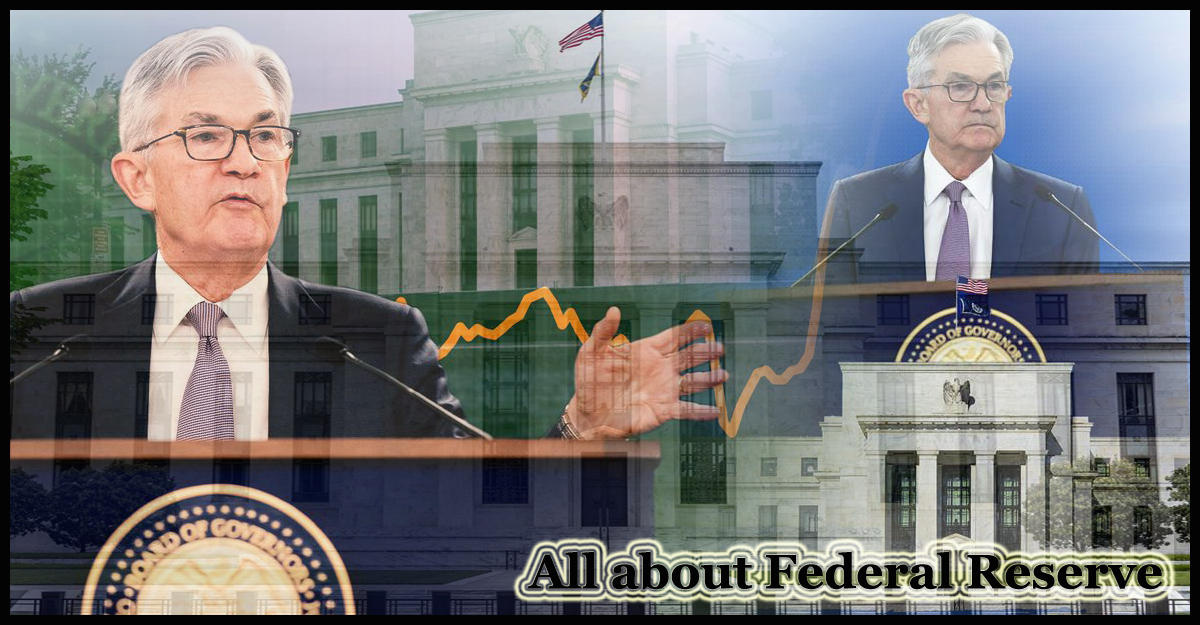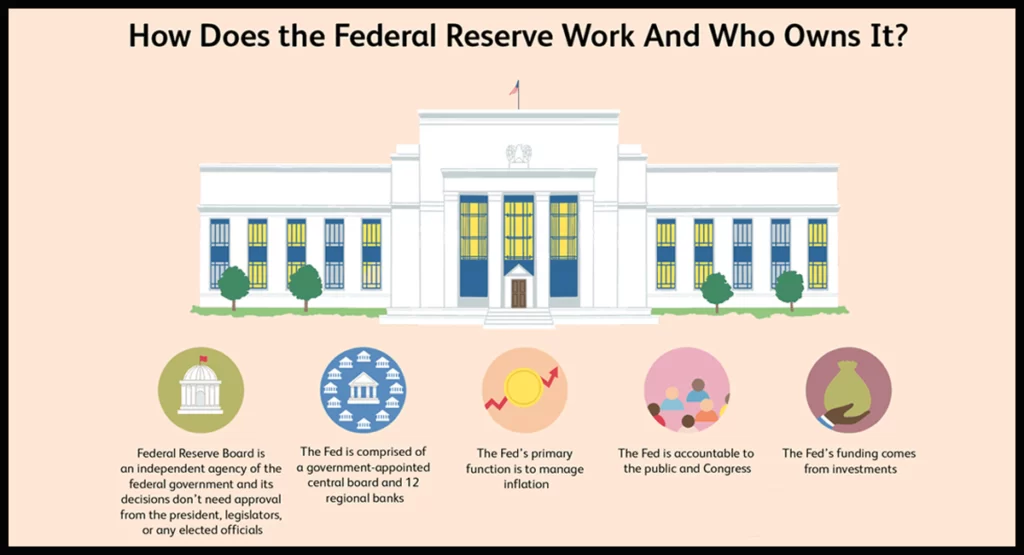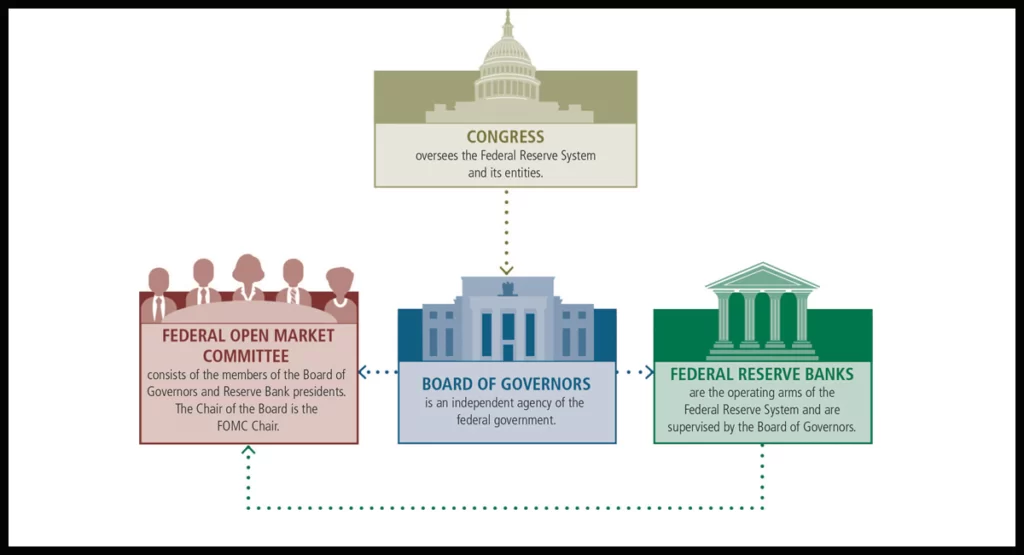
The Federal Reserve (also known as the “Fed”) is the central banking system of the United States.
It was established in 1913, and its primary purpose is to promote the stability and prosperity of the US economy by conducting monetary policy, supervising and regulating banks, and maintaining stability in the financial system.
The Fed consists of the Board of Governors, located in Washington, D.C., and 12 regional Federal Reserve Banks located throughout the country. The Federal Reserve operates independently within the government, and its decisions do not require presidential or congressional approval. The Fed is considered one of the most influential institutions in the world, as it has the power to control the supply of money and interest rates, which affect the economy on a global scale.
Here’s some additional information:

Monetary Policy: The Federal Reserve uses its monetary policy tools to influence the supply of money and credit, and ultimately, to affect the economy. For example, it can increase or decrease the federal funds rate, which is the interest rate at which banks lend money to each other overnight. This, in turn, can affect other interest rates and the availability of credit in the economy.
Regulation and Supervision: The Federal Reserve is responsible for supervising and regulating a significant portion of the U.S. banking system, including both state-chartered and nationally chartered banks. This helps ensure the safety and soundness of the financial system and protects consumers.
Financial Stability: The Fed works to maintain stability in the financial system by monitoring financial markets and institutions, and by taking action as necessary to address risks to the stability of the system. For example, during the 2008 financial crisis, the Fed provided emergency loans and other forms of financial assistance to stabilize the financial system.
FED Constitute The following Members

The Federal Reserve is governed by a seven-member Board of Governors, appointed by the President and confirmed by the Senate. The chair of the Board of Governors is considered the public face of the Fed, and the chair serves as the head of the Federal Reserve System. The current chair is Jerome Powell.
In conclusion, the Federal Reserve is a crucial component of the US financial system and economy, playing a key role in maintaining stability, promoting growth, and supervising and regulating the financial sector.
Here are some more details:
Structure: The Federal Reserve System is comprised of the Board of Governors, the 12 regional Federal Reserve Banks, and various committees and councils. The regional banks are responsible for implementing monetary policy and supervising banks in their respective districts. They also serve as a link between the central bank and the communities they serve.
Ownership: The Federal Reserve Banks are unique in that they are quasi-public entities. They are owned by commercial banks and operate for the benefit of the public. Each commercial bank that is a member of the Federal Reserve System must purchase stock in its regional Federal Reserve Bank, which gives it a partial ownership stake.
Transparency: The Federal Reserve strives to be transparent in its actions and decisions. It regularly releases information on its monetary policy decisions and goals, and provides updates on the state of the economy. Additionally, the Fed publishes detailed reports and releases on a regular basis to provide insight into its activities.
The Federal Open Market Committee (FOMC)
The Federal Open Market Committee (FOMC): The FOMC is the main monetary policy-making body of the Federal Reserve System. It is composed of 12 members: the seven members of the Board of Governors, and five of the 12 regional Federal Reserve Bank presidents. The FOMC meets regularly to assess economic conditions and make decisions on monetary policy.
Tools: The Federal Reserve has several tools at its disposal to implement monetary policy, including open market operations, the discount rate, and reserve requirements. Open market operations involve the purchase or sale of government securities on the open market, which affects the money supply and interest rates. The discount rate is the interest rate at which banks can borrow from the Federal Reserve, and reserve requirements are the minimum amount of funds that banks must hold in reserve.
In summary, the Federal Reserve System is a complex organization with a wide-ranging impact on the economy. Its structure, ownership, transparency, policy-making process. And tools give it the ability to play a significant role in promoting stability and prosperity in the US and beyond.
List of Federal Reserve Chairman
Here’s a list of the past and current chairmen of the Federal Reserve Board of Governors:
- Charles Sumner Hamlin (1914-1916)
- William P. G. Harding (1916-1922)
- Daniel Richard Crissinger (1923-1927)
- Roy Archibald (1927-1930)
- Eugene Isaac Meyer (1930-1933)
- Marriner S. Eccles (1934-1948)
- Thomas B. McCabe (1948-1951)
- William McChesney Martin Jr. (1951-1970)
- Arthur F. Burns (1970-1978)
- G. William Miller (1978-1979)
- Paul A. Volcker (1979-1987)
- Alan Greenspan (1987-2006)
- Ben S. Bernanke (2006-2014)
- Janet L. Yellen (2014-2018)
- Jerome H. Powell (2018-present)
Note: The above list includes only the chairmen of the Federal Reserve Board of Governors. There have also been several interim chairmen who served briefly during times when a new chairman was being appointed.
All about The Federal Open Market Committee
The Federal Open Market Committee (FOMC) is the main policy-making body of the Federal Reserve System. It is responsible for setting monetary policy in the United States and oversees the implementation of that policy through open market operations. The FOMC consists of 12 members: the seven members of the Board of Governors of the Federal Reserve System. And 5 of the 12 Federal Reserve Bank presidents.
The FOMC meets regularly, usually eight times per yea. To assess the state of the economy and to make decisions on monetary policy. The committee sets targets for the federal funds rate, which is the interest rate at which banks lend to each other overnight. And it uses open market operations to influence the money supply and achieve its objectives.
In addition to setting monetary policy. The FOMC also releases regular statements and reports to provide transparency and insight into its decision-making process. These statements and reports can have a significant impact on financial markets and the economy. And as they provide information on the FOMC’s outlook for the economy and its plans for future policy actions.
The FOMC operates independently within the Federal Reserve System and its decisions do not require approval from the President or Congress. However, the FOMC is accountable to the public and is subject to congressional oversight.
In conclusion, the Federal Open Market Committee is a key component of the Federal Reserve System. And plays a critical role in shaping monetary policy in the United States. Its actions have a major impact on the economy and financial markets, both domestically and globally.
Also Read – Government Policies for Rural India
Here’s some additional information: Federal Reserve
Tools: The FOMC has a variety of tools it can use to implement monetary policy. Also including open market operations, the discount rate, and reserve requirements.
Open market operations: This is the primary tool the FOMC uses to influence the money supply and interest rates. Through open market operations, the FOMC buys or sells government securities, such as Treasury bonds, on the open market. By increasing or decreasing the amount of securities held by banks. The FOMC can influence the money supply and the federal funds rate. Which is the interest rate at which banks lend to each other overnight.
Discount rate: The Discount rate is the interest rate at which Depository Iinstitutions. Such as commercial banks, can borrow from their Regional Federal Reserve Bank. By Adjusting the Discount rate, the FOMC can influence the cost of Borrowing for banks. Which can affect lending and the overall level of Economic activity.
Reserve Requirements: Reserve requirements are the minimum amount of funds that banks must hold in reserve. By changing the reserve requirements, the FOMC can influence the amount of funds available for lending. Which can impact the level of economic activity.
Also Read – Green Tea and its Benefits
The Federal Open Market Committee
Transparency: The FOMC strives to be transparent in its decision-making process and regularly releases statements. Reports, and minutes of its meetings to provide insight into its actions and outlook. The FOMC also holds regular press conferences to provide additional information and answer questions from the public and media.
Communication with the Public: The FOMC uses various methods to communicate its views and actions to the public. In addition to regular statements and reports. The FOMC also uses its website, social media, and other tools to share information and provide updates on its activities.
In conclusion, the Federal Open Market Committee is a critical component of the Federal Reserve System. And plays a crucial role in shaping monetary policy in the United States. Its actions, tools, transparency, and communication with the public help to ensure the stability and prosperity of the US economy.
Also Read – All about Indian Union Budget and its Features

One thought on “All about Federal Reserve”